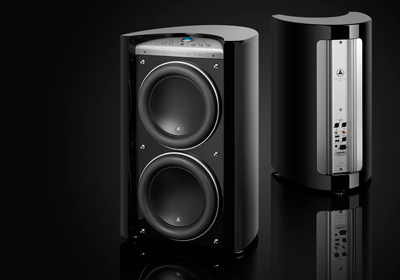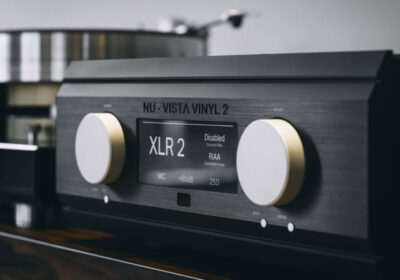We’ve recently introduced Hana moving coil cartridges to our product range. While these Moving coil cartridges may seem like just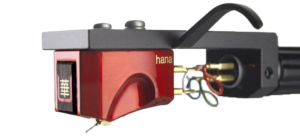
Below is an explainer covering phono cartridges in general.
What is the difference between a moving coil and a moving magnet cartridge?
Firstly, it is essential to know that both cartridges utilise coils and magnets, converting the minute mechanical movement of the stylus in the record grove into an electrical signal. The difference is the placement of both pieces.
In the case of a moving magnet cartridge, the magnets are situated at the end of the cantilever (the small shaft that holds the diamond stylus), which sits between two coils mounted in the cartridge body.
In the case of a moving coil cartridge, the coils are situated on the cantilever, with the magnets being mounted as part of the cartridge body.
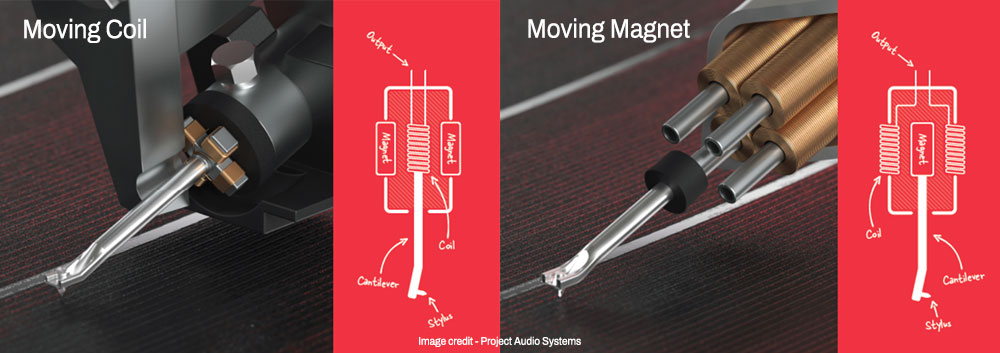
What are the advantages of a moving magnet cartridge?
- Moving magnet cartridges are cheaper to manufacture and tend to be more robust.
- The design allows for the styli to be replaced if damaged or worn.
What are the disadvantages of a Moving Magnet cartridge:
- Moving magnet cartridges are heavier than Moving coil cartridges, resulting in poorer performance.
What are the advantages of a moving coil cartridge?
- Moving coil cartridges are lighter in weight than a moving magnet. This allows the stylus to track the record groove more accurately – resulting in superior performance.
What are the disadvantages of a moving coil cartridge?
- Cost – they are more challenging to manufacture.
- The design does not allow for the styli to be easily replaced, and if it becomes damaged or worn, the usual option is a trade-back scheme – return the old unit and get an allowance against a new one.
- Output – in most cases, the output of a moving coil is much lower than a moving magnet and needs a dedicated MC step-up device. Many amplifiers have a dedicated MC input, but most don’t, requiring an additional external device.
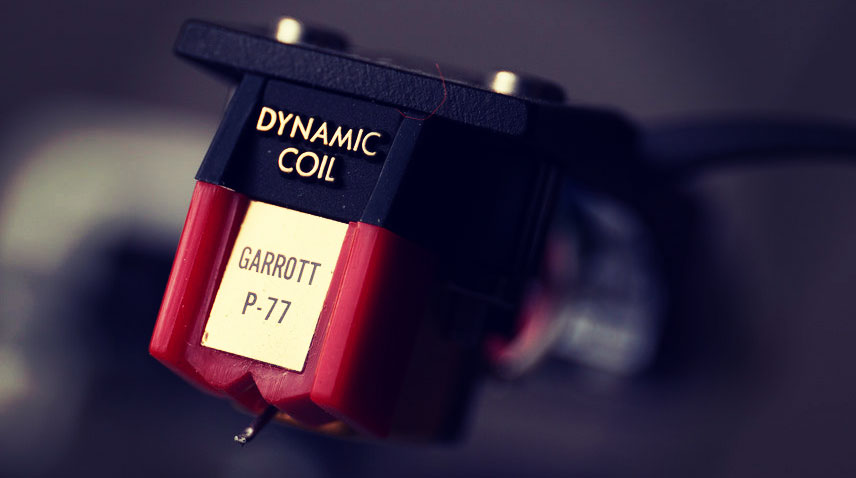
“The Garrott Brothers P77i moving magnet. Priced at $799,
this is one of the best value-for-money cartridges on the market (and it’s Australian).”
What is a Nude Diamond?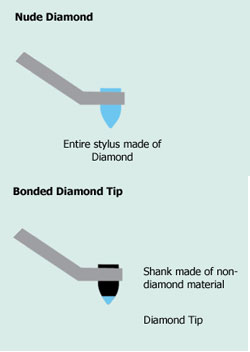
The diamond stylus must be attached to the cantilever, and two methods can achieve this.
The less expensive process involves mounting a metal shank to the cantilever and then fastening the diamond tip to the metal shank – usually called a bonded stylus.
The ‘Nude’ procedure means the entire stylus is manufactured from diamond, with the diamond shaft mounted directly to the cantilever. There are several advantages to this design.
- Firstly, a Nude diamond is usually lighter, allowing them to track more accurately.
- Most Nude styli are grain-oriented, with longer-wearing faces in contact with the record groove, giving longer wear.
- The joining in a bonded stylus can impact the resonance resulting from the tracking process. Admittedly, this is a minor impact, but remember that the output of a phono cartridge is very low, and needs to be amplified by a phono stage, so any deficiencies are also amplified.
- Reliability – Nude diamonds tend to be more reliable than bonded alternatives.
What is the best stylus shape?
You may be surprised that the diamond tip of your stylus can come in many shapes.
Conical.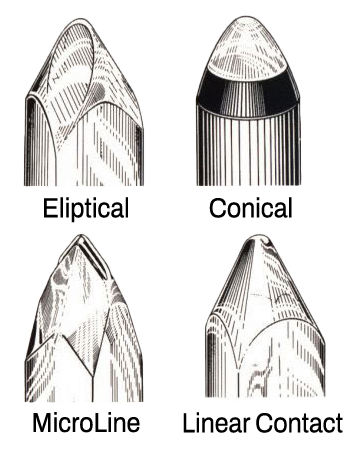
Due purely to economics, the most common is conical – the diamond tip is round. While adequate for lower-priced systems, this design has some drawbacks impacting the system’s performance. The large contact area of the diamond only touches the centre of the groove walls, and its broad shape means that it does not make good contact with the finer (high frequency) modulations in the groove wall.
Elliptical (and variations).
The diamond tip is shaped like an ellipse, which sits across the groove. This allows greater contact with the finer modulations in the groove wall.
Line Contact (and variations)
This is shaped like an elliptical stylus with the front and back further shaved away, giving even better contact, resulting in better high-frequency response and lower distortion.
Shibata.
Shaped a little like a cross between elliptical and Line Contact, the Shibata shape was initially designed with the advent of Quadrophonic in the early 1970s, where the rear channels were pressed in very high-frequency modulations in the record groove and needed to be extracted without damaging the record. When Quadrophonic disappeared, the advantages of this design for normal high-frequency retrieval were evident, and the technology lived on.
The Hana SL cartridge features a Shibata stylus.
MicroRidge/MicroLine (and variations).
This rather complex design is the closest to the shape of the cutting stylus used to produce the original master discs. This shape does the best job of tracking the groove wall and arguably retrieves the most information while delivering the flattest frequency response of all variants. The contact ridges are only a few microns across and are manufactured via laser-cut technology.
The Hana ML cartridges feature a MicroLine stylus.
The other cartridge which uses a variation on this design (Microscanner) is the Garrott Brothers P77i moving magnet. Priced at $799, this is one of the best value-for-money cartridges on the market (and it’s Australian).
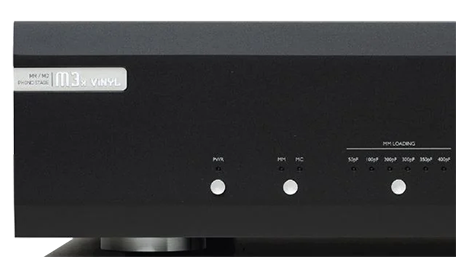
Why do I need a phono amplifier?
Most source equipment connected to your amplifier (streamer, CD player, tuner, etc.) has an output voltage of around 2.5 volts, which the amplifier then amplifies to a level capable of driving your speakers. In the case of moving magnet cartridges, the output is around 3 to 6mv; and in the case of moving coil cartridges, this drops to around 0.5mv.
This signal needs to be amplified to a level aligning it with the other inputs connected.
Most amplifiers have an MM (moving magnet) phono amplifier built, and some have MC (moving coil). If not, numerous companies manufacture stand-alone phono stages that will connect to your amplifier (Musical Fidelity being an obvious choice); alternatively, several manufacturers have added phono stages to their turntables (the Yamaha TT-S303B, which sells for $699, is a very good example of this).
Upgrading your phono cartridge can be one of the most cost-effective and rewarding upgrades you can make to your system. At Len Wallis Audio, we understand the importance of finding the perfect cartridge to match your preferences and setup. That’s why we invite you to visit our showroom and have a conversation with our expert staff. They’ll be delighted to guide you through the intricate world of moving coil (MC) and moving magnet (MM) cartridges, explaining the nuances, demonstrating their capabilities, and helping you choose the ideal one for your vinyl journey.


